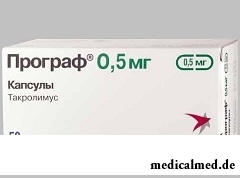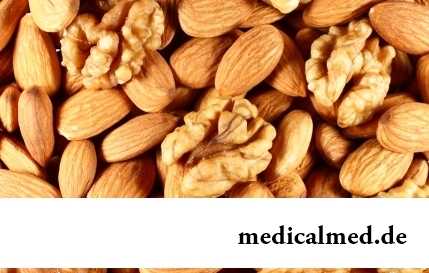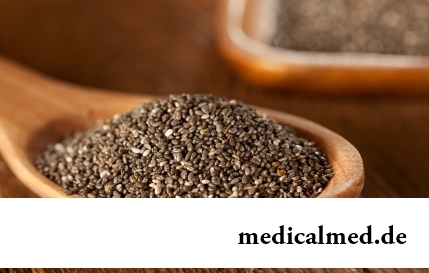





Pro-count
Application instruction:
 The pro-count – drug with an immunodepressive effect.
The pro-count – drug with an immunodepressive effect.
Form of release and structure
Dosage forms of release of the Pro-count:
- Capsules: firm gelatinous, lid and case opaque; capsules contain white powder; on 0,5 mg: the size No. 5, light yellow, on a lid – a text of "0,5 mg" of red color, on the case – [f] 607"; on 1 mg: the size No. 5, white, on a lid – a text of "1 mg" of red color, on the case – 617"; on 5 mg: the size No. 4, grayish-red, on a lid – a text of "5 mg" of white color, on the case – 657" (in blisters on 10 pieces, on 5 blisters in packages from aluminum foil of the maintenance of 1 g of silica gel, on 1 package in a cardboard pack);
- Concentrate for preparation of solution for intravenous administration: transparent, colourless (on 1 ml in glass ampoules of 2 ml, on 10 ampoules in blister strip packagings, on 1 packaging in a cardboard pack).
Structure of 1 capsule:
- Active agent: такролимус – 0,5, 1 or 5 mg;
- Auxiliary components (0,5/1/5 mg): a gipromelloza – 0,5/1/5 mg, croscarmellose sodium – 0,5/1/5 mg, monohydrate of lactose – 62,85/61,35/123,6 mg, magnesium stearate – 0,65/0,65/1,4 mg;
- Capsule (0,5/1/5 mg): titanium dioxide (E171) – 0,338/0,395/0,564 mg, yellow iron oxide (E172) – 0,048/0/0,008 mg, gelatin – 23,414/23,405/33,428 mg, the purified water – 4,2/4,2/6 mg;
- Ink for a text: Opacode S-1-15083 (glaze pharmaceutical (shellac solution in ethanol)) – 60,7%, soy lecithin – 0,48%, SDA3A brand alcohol (methanol, ethanol) – 5%, симетикон – 0,01%, dye red iron oxide (E172) – 20%, a hypro rod – 0,3%, N - butyl alcohol – 9,51%, the purified water – 4%.
Structure of 1 ml of a concentrate:
- Active agent: такролимус – 5 mg;
- Auxiliary components: the castor oil (Sales tax-60) hydrogenated by polyoxyethylene – 200 mg, anhydrous alcohol – 638 mg.
Indications to use
- Rejection of allotransplant of a liver, kidney or heart (for the purpose of the prevention);
- Rejection of allotransplant, resistant to other modes of immunosuppressive therapy (treatment).
Contraindications
Contraindication to use of the Pro-count is hypersensitivity to drug components, and also to other macroleads.
To pregnant women of Pro-columns appoint only in cases if the expected advantage of its use for mother is higher than potential risk for the child. In need of performing treatment at women in the period of a lactation breastfeeding should be interrupted.
Route of administration and dosage
The pro-count it is necessary to apply under careful control from the personnel having necessary qualification. Only specialists with experience of use of drug for patients with transplanted organs can appoint or make changes to immunosuppressive therapy.
Parenterally the Pro-count enter if the condition of the patient does not allow it to accept drug in the form of capsules. Right after improvement (but not longer than 7 days) the patient is transferred to administration of drug inside.
It is necessary to consider that uncontrolledly to transfer patients from one drug of a takrolimus on another it is unsafe (possibly graft rejection or increase in frequency of side reactions). Change of the mode of dosing or a dosage form perhaps only under control of the specialist in the field of transplantology. A transfer has to be made under careful monitoring of concentration of a takrolimus in blood and with correction of a dose of drug.
At the initial stage usually appoint the combined use of the Pro-count with other immunodepressants. Depending on the mode of immunosuppressive therapy the dose can vary. The choice of a dose is based, first of all, on clinical assessment of risk of rejection and individual portability of the Pro-count, and also on data of monitoring of concentration of a takrolimus in blood.
In case of clinical signs of rejection it is necessary to consider a question of correction of the mode of dosing.
Duration of therapy is not limited.
The Pro-columns capsules, as a rule, accept inside, washing down with liquid (it is more preferable – water). It is recommended to observe a break with meal (1 hour to or in 2 hours after food). In case of need contents of capsules are mixed with water and entered via the nazogastralny probe.
At the admission of reception of the capsule the subsequent dose is not doubled.
The daily dose is divided into 2 equal parts which accept in the morning and in the evening. Capsules need to be accepted right after their extraction from the blister.
Before introduction a concentrate of the Pro-count it is necessary to part 5% with solution of a dextrose or 0,9% sodium chloride solution. It is possible to use only colourless and transparent solutions. It is impossible to administer the drug not divorced.
The pro-count it is possible to enter only intravenously in the form of infusion. It is impossible to combine solution with other drugs with the alkaline environment (in the alkaline environment такролимус it is unstable). Jet administration of drug is not recommended.
After cultivation concentration of solution has to be in limits of 4-100 mkg/ml. The total amount of infusion – 20-500 ml, infusion time – 24 hours.
The dosing mode at transplantation of a liver:
- Primary immunosuppression (children): a daily initial dose (capsules) – 300 mkg/kg. At impossibility to accept drug inside treatment begin with intravenous administration of infusion solution in a dose of 50 mkg/kg;
- Primary immunosuppression (adults): a daily initial dose (capsules) – 100-200 mkg/kg. It is desirable to begin therapy in 12 hours after completion of operation. At impossibility to accept drug inside treatment begin with intravenous administration of infusion solution in a dose of 10-50 mkg/kg;
- Maintenance therapy (children and adults): the dose decline and cancellation of the accompanying immunosuppressive therapy is possible (the Pro-count apply as monotherapy);
- Rejection treatment (children and adults): appoint higher doses in combination with corticosteroids and mono/polyclonal antibodies (short courses). At emergence of signs of toxicity decrease in a dose of drug can be required. At transfer of patients into therapy by the Pro-count use of the same initial doses, as is recommended at primary immunosuppression.
The dosing mode at transplantation of a kidney:
- Primary immunosuppression (children): a daily initial dose (capsules) – 300 mkg/kg. At impossibility to accept drug inside treatment begin with intravenous administration of infusion solution in a dose of 75-100 mkg/kg;
- Primary immunosuppression (adults): a daily initial dose (capsules) – 200-300 mkg/kg. It is desirable to begin therapy in 24 hours after completion of operation. At impossibility to accept drug inside treatment begin with intravenous administration of infusion solution in a dose of 50-100 mkg/kg;
- Maintenance therapy (children and adults): the dose decline is possible, the Pro-count leave as basic component of double therapy;
- Rejection treatment (children and adults): appoint higher doses in combination with corticosteroids and mono/polyclonal antibodies (short courses). At emergence of signs of toxicity decrease in a dose of drug can be required. At transfer of patients into therapy by the Pro-count use of the same initial doses, as is recommended at primary immunosuppression.
The dosing mode at transplantation of heart:
- Primary immunosuppression (children): The pro-count appoint as monotherapy or along with induction by antibodies. Monotherapy: an initial dose of infusion solution – 30-50 mkg/kg (before achievement of concentration of a takrolimus in whole blood of 15-25 ng/ml). At the first clinical possibility of the patient transfer to oral administration in an initial dose 300 mkg/kg (in 8-12 hours after the infusion termination). At appointment of the Pro-count after induction antibodies drug is appointed inside in an initial dose of 100-300 mkg/kg;
- Primary immunosuppression (adults): use of drug in combination with induction therapy by antibodies (allows to delay the beginning of therapy by the Pro-count), at clinically stable patients – without purpose of antibodies is possible. After induction a daily initial dose (capsules) – 75 mkg/kg. It is desirable to begin therapy within 5 days after operation (after stabilization of a state). At impossibility to accept drug inside treatment begin with intravenous administration of infusion solution in a dose of 10-20 mkg/kg. Alternative approach (for patients without signs of disturbance of functions of internals (for example, kidneys)) – the Pro-column capsules appoint within 12 hours after transplantation in an initial daily dose 2000-4000 mkg along with a mikofenolat mofetily both corticosteroids or sirolimusy and corticosteroids;
- Maintenance therapy (children and adults): the dose decline is possible;
- Rejection treatment (children and adults): appoint higher doses in combination with corticosteroids and mono/polyclonal antibodies (short courses).
At transfer of patients into reception of the Pro-count inside the initial daily dose makes: adult – 150 mkg/kg, children – 200-300 mkg/kg.
The dosing mode at treatment of rejection after allotransplantation of other bodies (an initial daily dose):
- Lung: 100-150 mkg/kg;
- Pancreas: 200 mkg/kg;
- Small bowel: 300 mkg/kg.
Side effects
It is difficult to establish an exact profile of side reactions of immunodepressants that is connected with features of the main disease and a large amount of drugs which are used after transplantation.
The disturbances which are often described below have reversible character, and/or their expressiveness decreases at reduction of a dose.
Possible side reactions (> 10% – are very frequent;> 1% and <10% – is frequent;> 0,1% and <1% – infrequently;> 0,01% and <0,1% – are rare; <0,01% – are very rare):
- Nervous system: very often – a headache, a tremor; often – consciousness disturbances, a convulsive syndrome of various genesis, a dizesteziya and paresthesia, dizziness, a peripheral neuropathy, disturbance of the letter; infrequently – a coma, paresis and paralysis, hemorrhages in the central nervous system and disturbances of cerebral circulation, amnesia, encephalopathy, disturbances of an articulation and the speech; seldom – increase in a muscle tone; very seldom – a myasthenia;
- Cardiovascular system: very often – arterial hypertension; often – tachycardia, disturbances of coronary circulation, tromboembolic and ischemic episodes, disturbance of peripheric circulation, arterial hypotension; infrequently – shock, ventricular arrhythmias and a cardiac standstill, a heart attack, heart failure, abnormal indicators of an ECG, a deep vein thrombosis of extremities, a cardiopalmus, a cardiomyopathy, a hypertrophy of ventricles, supraventricular arrhythmias, arrhythmia, change of pulse and heart rate; seldom – a pericardiac exudate; very seldom – disturbance of indicators of an ekhokardiogramma;
- Coagulant system of blood: often – bleeding; infrequently – deviations in indicators of a koagulogramma, a coagulopathy; seldom – a prothrombinopenia, a trombotichesky Werlhof's disease;
- Respiratory system: often – pharyngitis, pulmonary parenchymatous frustration, an asthma, a pleural exudate, a nose congestion, cough, rhinitis; infrequently – disorders of airways, respiratory insufficiency, asthma; seldom – an acute respiratory distress syndrome;
- Hemopoietic system: often – thrombocytopenia, anemia, a leukopenia, a leukocytosis, increase or decrease in level of a hematocrit and/or hemoglobin; infrequently – a neutropenia, a pancytopenia;
- Gepatobiliarny system: often – abnormal liver functions, increase in activity of liver enzymes, jaundice and a cholestasia, defeat of cells of a liver and hepatitis, a cholangitis; seldom – an obliterating endophlebitis of hepatic veins, fibrinferments of a hepatic artery; very seldom – a stenosis of bilious channels, a liver failure;
- Alimentary system: very often – nausea, diarrhea; often – inflammatory diseases of digestive tract, gastrointestinal ulcers, perforations and bleedings, an ulceration of a mucous membrane of an oral cavity and stomatitis, vomiting, ascites, gastrointestinal and abdominal pain, dyspepsia, a meteorism, locks, feeling of a raspiraniye and swelling in a stomach, a liquid chair; infrequently – paralytic intestinal impassability, disturbance of evakuatorny function of a stomach, peritonitis, pancreatitis (chronic and acute), a gastroesophageal reflux disease, increase in activity of amylase in blood; seldom – pancreatic pseudocysts, субилеус;
- Skeletal and muscular system: often – muscular spasms, an arthralgia, a dorsodynia and extremities; infrequently – joint frustration;
- Urinary system: very often – a renal failure; often – an oliguria, a renal failure, an acute renal failure, an uric syndrome, an acute canalicular necrosis, a toxic nephropathy, disorders of a bladder and urethra; infrequently – a hemolitic uraemic syndrome, an anury; very seldom – hemorrhagic cystitis, a nephropathy;
- Endocrine system: very often – a diabetes mellitus, a hyperglycemia; seldom – a hirsutism;
- Immune system: anaphylactic and allergic reactions;
- Reproductive system: infrequently – uterine bleeding and a dysmenorrhea;
- Mentality: very often – sleeplessness; often – uneasiness, dreadful dreams, a disorientation and confusion of consciousness, a hallucination, the suppressed mood, a depression, emotional frustration; infrequently – psychotic frustration;
- Sense bodys: often – diseases of eyes, a sight illegibility, photophobia, noise (ring) in ears; infrequently – decrease in hearing, a cataract; seldom – neurosensory deafness, a blindness; very seldom – a hearing disorder;
- Metabolism: very often – a hyperpotassemia; often – a hypophosphatemia, a hypomagnesiemia, electrolytic disturbances, a hyperuricemia, a hypopotassemia, a gipertriglitseridemiya, a hyponatremia, a hypocalcemia, a hypervolemia, a loss of appetite, anorexia, a lipidemia, a metabolic acidosis, a hypercholesterolemia; infrequently – dehydration, a hyperphosphatemia, a hypoproteinemia, a hypoglycemia; very seldom – increase in mass of fatty tissue;
- Dermatological reactions: often – an acne, rash, an itch, an alopecia, a hyperhidrosis; infrequently – a photosensitization, dermatitis; seldom – a toxic epidermal necrolysis (Lyell's disease); very seldom – Stephens-Johnson's syndrome;
- New growths (malignant, high-quality, not identified): increase in risk of development of malignant tumors, including Epstein-Barre's (EBV) virus – the associated limfoproliferativny diseases and a carcinoma cutaneum;
- Invasions and infections: increase in risk of development of generalized and local infectious diseases (virus, bacterial, fungal, protozoan etiology). Deterioration in a course of earlier diagnosed infectious diseases is possible;
- Organism in general: often – discomfort and pain, an adynamy, hypostases, disturbances of perception of body temperature, feverish states, increase in activity of an alkaline phosphatase, increase in body weight; infrequently – decrease in body weight, disturbance of perception of ambient temperature, multiorgan insufficiency, deterioration in health, a grippopodobny syndrome, feeling of squeezing in a breast, feeling of alarm, increase in activity of a lactate dehydrogenase; seldom – difficulties of the movement, thirst, feeling of constraint in a thorax, loss of balance (falling);
- Transplant: often – primary dysfunction of a transplant.
Special instructions
During an initial stage after transplantation it is regularly necessary to carry out monitoring of such parameters as: arterial pressure, glycemia level on an empty stomach, ECG, neurologic status and condition of sight, concentration of electrolytes, indicators of renal and hepatic function, koagulogramm, hematologic indicators, proteinemia level. At clinically significant changes carry out correction of immunosuppressive therapy.
During treatment it is necessary to avoid purpose of phytodrugs with the maintenance of a St. John's Wort, and also other vegetable means which can lead to decrease (change) in concentration of a takrolimus in blood.
At diarrhea considerable changes of concentration of a takrolimus in blood can be observed (careful monitoring is necessary).
During therapy development of a hypertrophy of ventricles or partitions of heart is possible (usually has reversible character and arises at exceeding recommended concentration of a takrolimus in blood). Patients with high risk of development of similar disturbances should carry out echocardiographic and an ECG control.
The combined use of cyclosporine with takrolimusy should be avoided.
At patients who underwent therapy takrolimusy earlier post-transplant limfoproliferativny diseases (PTLZ) associated with Epstein-Barre's virus (in the course of treatment carrying out careful monitoring by means of polymerase chain reaction is recommended) can develop.
There are data on development against the background of therapy takrolimusy a syndrome of reversible back encephalopathy. At emergence of such symptoms as visual disturbances, a headache, spasms and mental disturbances, it is necessary to carry out MRT. In cases of confirmation of the diagnosis exercise adequate control of arterial pressure and spasms, and also immediately stop system introduction of a takrolimus (as a rule, this state is completely reversible).
During use of the Pro-count the probability of development of the opportunistic infections caused by protozoa, mushrooms, bacteria, viruses (it is connected with deep suppression of immune system and can lead to heavy or lethal outcomes), and malignant new growths increases (in particular, skin in this connection it is recommended to limit ultra-violet radiation and insolation, to use sun-protection means with a high factor of protection).
The risk of developing of secondary cancer is unknown.
Lactose therefore at its appointment as the patient with rare hereditary diseases (intolerance of a galactose, insufficiency of lactase or glyukozo-galaktozny malabsorption) it is necessary to observe extra care is a part of the Pro-columns capsules.
Accidental administration of infusion solution in perivascular space or an artery can lead to irritation in the field of introduction.
At control of motor transport and work with potentially dangerous mechanisms it is necessary to be careful, considering that the Pro-count (in particular in combination with alcohol) can cause neurologic and visual frustration.
Medicinal interaction
At the combined use of the Pro-count with some medicinal means / substances the following effects can be observed:
- Medicines or plants with the action established inhibiting or inducing on CYP3A4: increase or decrease in concentration of a takrolimus in blood;
- Antifungal means, makrolidny antibiotics, HIV inhibitors of proteases, grapefruit juice: increase in concentration of a takrolimus in blood (dose adjustment can be required);
- Gestoden, Bromocriptinum, cortisone, Norethisteronum, dapsone, ergotamine, lidocaine, Mephenytoinum, Miconazolum, midazolam, quinidine, Tamoxifenum, Oleandomycinum: inhibition of metabolism of a takrolimus;
- Rifampicin, Phenytoinum, St. John's Wort: essential decrease in concentration of a takrolimus (dose adjustment can be required);
- Phenobarbital: clinically significant interaction;
- Corticosteroids (in maintenance doses), carbamazepine, an isoniazid, metamizol: decrease in concentration of a takrolimus in blood;
- Methylprednisolonum, Prednisolonum (in high doses): increase or reduction of concentration of a takrolimus in blood;
- Cyclosporine: increase in an elimination half-life, probability of development of the synergy/additive nephrotoxic effects (the combination is not recommended);
- Phenytoinum: increase in concentration of a takrolimus in blood;
- The drugs possessing nefro-or a neurotoxicity: strengthening of these effects;
- Hormonal contraceptives: decrease in their clearance;
- Pentobarbital, phenazone: decrease in their clearance and increase in an elimination half-life;
- Pro-kinetic means, Cimetidinum, magnesium hydroxide, aluminum hydroxide: increase in system exposure of a takrolimus;
- The drugs having high affinity to proteins of a blood plasma (peroral anticoagulants, non-steroidal anti-inflammatory drugs, peroral hypoglycemic means): competitive interaction;
- Amphotericinum In, an ibuprofen: nephrotoxicity strengthening;
- Potassium or kaliysberegayushchy diuretics: development or strengthening of a hyperpotassemia;
- Live attenuated vaccines: decrease in efficiency (it is recommended to avoid the combined use).
Syringes, test tubes and other equipment which is used for preparation of suspension from capsules and preparation and administration of infusion solution should not contain polyvinylchloride.
Terms and storage conditions
To store in protected from light, the place, dry, unavailable to children, at a temperature up to 25 °C.
Period of validity:
- Capsules – 3 years; after opening of the aluminum soldered package – 1 year;
- Infusion solution – 2 years; solution after cultivation can be stored for 24 hours in glass, polypropylene or polyethylene vessels at a temperature of 2-8 °C.
Name of drug
Price
Drugstore
Work which to the person not to liking, is much more harmful to his mentality, than lack of work in general.

From the failure of work of immune system which is shown in the form of an allergy, statistically, more than 40% of the population of the globe suffer. In большинс...
Section: Articles about health
The popular expression "run from a heart attack" became the motto of the people supporting active lifestyle. Moreover, run became a peculiar fashionable tendency: sales of racetracks and the accompanying goods for run are at permanently high level. Really...
Section: Articles about health
History of mankind contains several tens of epidemics whose emergence was compared by eyewitnesses and historians to doomsday. The most terrible of them claimed the lives of millions of people, having made even the whole people to the person of the earth. What they − the diseases striking terror? Whether it managed to the person to find treatment, or he is still powerless before forces of nature?...
Section: Articles about health
For the person who daily since morning gathers for work it is very important to wake up vigorous and ready by day of work. On most...
Section: Articles about health
The medicine promptly develops, and the fact that else quite recently it seemed by miracle can now. We are not surprised any more to the fact that people with artificial joints and extremities can play sports, organ transplantation became a routine, and the latest cancer medicine п...
Section: Articles about health
For the last decades the diabetes mellitus of the second type became really world problem. The number of cases annually increases, and average age of patients for whom the illness is diagnosed, steadily decreases. Specialists consider that one of the main reasons for this trouble is disturbance of a diet. In other words, the huge number of people regularly overeats or excessively is fond of the products causing glucose exchange process failures....
Section: Articles about health
Each person has easy indispositions which he transfers "standing", trying not to ask for medical care. Argu...
Section: Articles about health
Separate food - the system of meal based on digestion physiology which is carried to improvement methods. According to nutritionists, the separate use of the carbohydrate and proteinaceous products demanding different conditions of assimilation helps to get rid from Bol...
Section: Articles about health
Sugar - the digestible refined product which is not of special value for an organism of the modern person. The use of sugar in food is based rather on the psychological dependence caused by desire to indulge itself with something tasty, and further and the biological, caused need of an organism for glucose as a result of big emissions of insulin in blood. Such circulation of insulin and glucose with continuous increase in portions of sugar is rather offensive and can become the reason for a narusha...
Section: Articles about health
The naturopathy sometimes moves as the new direction of medicine, something like fashionable hobby, and there is nothing farther from the truth....
Section: Articles about health
The body of the person almost for 60% consists of water. It is so important for normal functioning of an organism that loss of only one and a half percent of liquid already leads to the most unpleasant effects. The problems connected with deficit of water can overtake and...
Section: Articles about health
The chia plant, or the Spanish sage, is from South America. The indigenous people of the continent since ancient times used its seeds in food: small, but very nutritious kernels, in a form the reminding fasolina. Indians knew about useful properties of seeds of a chia, and applied them to maintenance of vitality and increase in endurance before serious exercise stresses....
Section: Articles about health
It is known that the person for 80% consists of water which participates in all processes of an organism. The person loses liquid daily – in...
Section: Articles about health
The main role in development of a peptic ulcer of a stomach and duodenum the bacterium Helikobakter plays pilor. Activity and the strengthened reproduction of this microorganism lead to weakening of protection of mucous membranes and their erosive damage. Manifestations not...
Section: Articles about health
For anybody not a secret that the modern person eats not as his ancestors. For the last 100 years in broad access there were absolutely new products which are result of use of the latest technologies in food production. Significantly ways of storage and transportation of food ingredients changed, and people of the whole world had an opportunity to regularly use those products about which their grandfathers and grandmothers did not even know....
Section: Articles about health
All of us, unfortunately, should face flu nearly an every year. It would seem, so frequent disease has to be study...
Section: Articles about health
It is difficult to revaluate importance of kidneys for an organism. These bodies not only perform work on purification of blood of decomposition products and removal of excess liquid. They are responsible also for production of some hormones necessary for normality maintenance...
Section: Articles about health
The varicosity has familiarly many, statistically, this disease more than a half of all adult population. As a rule, the varicosis affects preferential superficial vessels, and is shown by characteristic cosmetic defects. The deep vein thrombosis as this illness at the initial stages can imperceptibly proceed is represented much more dangerous, and in the started cases threatens with serious danger – thrombosis. This state, when the blood clot formed...
Section: Articles about health
Each person knows that fervescence is an illness sign. However about existence of diseases can to suite...
Section: Articles about health
Eyes – unique body on the structure thanks to which the person obtains about 80% of information on the world around: about a form, color, size, the movement, and also many other parameters of objects or phenomena. But whether much we know about the most valuable body...
Section: Articles about health
Cold is such painful that each sigh becomes a victory, heat "knocks" down, and the ache in joints forces to think only of pain. Some people with approach of the first symptoms of cold make the self-sacrificing decision to have a disease standing, and at best to rest in bed with a cup of hot tea. There is an opinion that if not to treat cold, then the organism itself, sooner or later, will overcome an illness. Whether so it? It is known that if in time it is simple not to begin treatment, apparently, harmless...
Section: Articles about health
Childbirth is the most important event in life of each woman. We are women we give birth to the new little man on this light. Now...
Section: Articles about health
During foot walks blood moves on vessels more actively and one and all bodies are supplied with a large amount of oxygen. It affects the state of health of the person very positively....
Section: Slideshow
Transfusion of donor blood has almost century history. In spite of the fact that this procedure is quite usual for many people, process of blood donation is still surrounded with numerous myths. Today we aimed to discredit the most widespread of them....
Section: Articles about health
Feeding by a breast - the integral part of ideal motherhood allowing to come into contact with the kid and to create since early years...
Section: Articles about health
Statistically, in Russia about 34% of citizens smoke. Most of consumers of tobacco has problems with health sooner or later. Not only smokers, but also their relatives suffer. Besides, cigarettes are expensive, and need of their acquisition heavy bry...
Section: Articles about health
Not everyone can brag of the shining Hollywood smile. Even the person who is regularly visiting the stomatologist and watching of oral cavities over health periodically has problems: enamel of teeth darkens under the influence of some products, on it the deposits giving to teeth a grayish or yellowish shade collect....
Section: Articles about health

